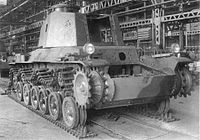Japanese tanks of World War II
The Imperial Japanese Army (IJA) initially purchased foreign tanks for evaluation during World War I, and began developing its own indigenous designs during the late 1920s.
[1] Near the end of World War I, the Japanese showed an interest in armored warfare and tanks and obtained a variety of models from foreign sources.
These models included one British Heavy Mk IV and six Medium Mark A Whippets, along with thirteen French Renault FTs (later designated Ko-Gata Sensha or "Type A Tank").
[5] Both types of tanks were still in active service in 1940, and additional vehicles and spare parts were obtained after the Japanese occupation of French Indochina.
As with many other nations at the time, the Japanese viewed the tank as a tool largely used in direct support of their infantry, and were rarely allowed independent action.
With their defeat by the Soviet Union at Nomonhan in 1939, the Japanese began to rethink their tank designs and doctrine, although their emphasis would continue to remain on supporting the infantry.
[7] In addition, the terrain of Southeast Asia and the islands of the Pacific were in general not suited to armored warfare, being largely tropical rainforests.
[9][10] For both security and logistical reasons, certain officers and engineers in the Japanese Army Technical Bureau during the early 1920s were adamant that future tanks should be made in Japan.
A special committee of the Imperial General Staff (Daihonei) worked on the feasibility of indigenous design and development of Japanese armor.
A team of engineers of the Technical Bureau participated in the development, including a young army officer, Major Tomio Hara.
At the time, there was little heavy industry allocated to the production of motor vehicles in Japan, so there were significant difficulties creating the prototype.
The tank had a complex parallelogram suspension system with two pairs of road bogie wheels per leaf spring arrangement.
[20] Hara designed a bell crank scissors suspension that paired the bogie wheels and connected them to a coil spring mounted horizontally outside the hull.
The IJA therefore began a program to develop a replacement tank for infantry support and with the out-break of war with China, the peacetime budgetary limitations were removed.
[36] The Type 97 medium tank Chi-Ha (九七式中戦車 チハ, Kyunana-shiki chu-sensha chiha) was the most widely produced Japanese medium tank of World War II, with about 25 mm thick armor on its turret sides, and 30 mm on its gun shield, considered average protection in the 1930s.
[38] Initial versions were armed with a low-velocity Type 97 57 mm tank gun that was designed to support the infantry, but its shortcomings became clear during the 1939 Battles of Khalkhin Gol against the Soviet Union.
[45] It was developed in 1938 to address deficiencies in the Type 95 design already apparent from combat experience in Manchukuo and China in the Second Sino-Japanese War.
[46] Even though the Hino Motors "Chi-Ni Model A" prototype was accepted after field trials as the new Type 98 light tank, series production did not begin until 1942.
[51][53] Even so, production did not begin until 1943, due to the higher priority of steel allocated to the Imperial Navy for warship construction.
[57][58] The Chi-Nu retained the same chassis and suspension of the Type 1 Chi-He, but with a new large hexagonal gun turret and a commander's cupola.
However, given the fact available raw materials were in very short supply, and with much of Japan's industrial infrastructure being destroyed by American strategic bombing in 1945, its production run was severely curtailed.
It was much larger than the Type 97 Chi-Ha, with a longer, wider, tall chassis, supported by seven road wheels on each side.
However, the project was abandoned to free up manpower and critical resources to concentrate on the development and production of the more practical Type 4 Chi-To medium tank.
[9] With the end of the Pacific War, an incomplete Type 5 prototype was seized by American forces during the occupation of Japan.
The superstructure for the main gun was placed at the rear, the engine was positioned in the center of the chassis and the driver's station was in the front hull section; all similar in design to the German Ferdinand/Elefant heavy tank destroyer.
[75] Another planned version was to have a twin 25 mm anti-aircraft gun mounted on top of the rear casemate superstructure.
[76] There was also a planned variant known as the Ho-Ri II, with the boxy superstructure for the main 105 mm cannon designed to be integral with the hull's sides and placed at the center of the chassis (similar to the German Jagdtiger).
All production units were for use by the Japanese Special Naval Landing Forces in campaigns in the Pacific with amphibious operations.
[93] The peak of Japanese tank production was in 1942, but declined afterwards owing to aircraft and warship priorities, along with material shortages.
[47] Japan developed many experimental and operative armored vehicles, tanks and tank-destroyer types throughout the war; but largely held them in reserve, for home-land defense.
















